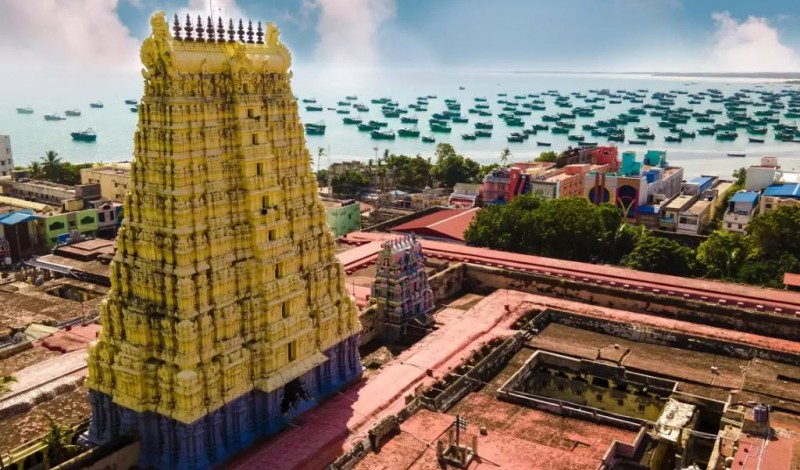
Rameshwaram Temple, nestled in the southern state of Tamil Nadu, India, stands as a testament to the rich cultural tapestry and religious diversity of the country. This iconic temple, revered by millions of devotees worldwide, holds a unique position not only as a place of worship but also as a symbol of historical significance. In this detailed exploration, we delve into the intricate facets of Rameshwaram Temple, unraveling its mythological origins, architectural grandeur, and enduring spiritual legacy.
Mythological Origins:
The genesis of Rameshwaram Temple is rooted in Hindu mythology, particularly the epic tale of Ramayana. According to legend, when Lord Rama, accompanied by his devoted allies including Hanuman and the Vanara sena, set out to rescue his beloved wife Sita from the clutches of the demon king Ravana, he encountered numerous challenges. One such challenge was the formidable task of crossing the vast ocean to reach the island stronghold of Lanka, where Sita was held captive. Faced with this daunting obstacle, Lord Rama sought the guidance and blessings of Lord Shiva, the supreme deity of destruction and transformation.
The pivotal moment in the narrative unfolds as Lord Rama, driven by unwavering devotion and determination, decides to perform penance to invoke Lord Shiva's divine intervention. On the shores of the ocean, amidst the swirling waves and golden sands, Lord Rama meticulously fashions a lingam out of the soft, pliable sand, symbolizing his reverence and devotion to Lord Shiva. With a heart filled with fervent prayers and a mind focused on the ultimate goal of rescuing Sita, Lord Rama begins his worship, beseeching Lord Shiva to grant him the strength and guidance to fulfill his sacred duty.
In a divine display of grace and compassion, Lord Shiva, pleased by Lord Rama's devotion and determination, manifests before him in the form of a resplendent light, illuminating the entire expanse of the ocean. This divine manifestation not only sanctifies the lingam crafted by Lord Rama but also bestows upon it the status of a sacred symbol, imbued with the presence and blessings of Lord Shiva himself. Thus, the lingam becomes enshrined as the presiding deity of Rameshwaram Temple, symbolizing the eternal bond between Lord Rama and Lord Shiva, and serving as a beacon of hope and inspiration for devotees through the ages.
Architectural Grandeur:
The architectural marvel of Rameshwaram Temple is a testament to the ingenuity and craftsmanship of ancient Indian artisans and craftsmen. Spread across a sprawling expanse of approximately 6 hectares, the temple complex is characterized by its towering gopuram, intricately carved pillars, and ornate sculptures depicting scenes from Hindu mythology and religious lore.
The imposing gopuram, rising to a height of 38.4 meters, serves as the iconic gateway to the temple, welcoming pilgrims and visitors from far and wide. Adorned with vibrant colors, intricate carvings, and elaborate motifs, the gopuram stands as a symbol of divine splendor and architectural brilliance.
As one steps into the sacred precincts of the temple, they are greeted by a mesmerizing array of shrines, halls, and courtyards, each exuding an aura of spiritual sanctity and divine grace. The central sanctum sanctorum, housing the principal deity Lord Ramanathaswamy, is adorned with exquisite sculptures and adorned with precious jewels, attracting devotees who come to offer their prayers and seek blessings.
Adjacent to the main shrine, lies the Garbha Griha of Goddess Vishalakshi, the divine consort of Lord Ramanathaswamy, surrounded by nine Jyotirlingas, believed to have been installed by Vibhishana, the brother of Ravana. These sacred lingams, representing the cosmic energy of Lord Shiva, serve as focal points of devotion and worship for devotees who come to pay homage to the divine.
Enduring Spiritual Legacy:
The spiritual legacy of Rameshwaram Temple transcends the boundaries of time and space, weaving together the threads of devotion, faith, and divine grace. For centuries, pilgrims from all walks of life have embarked on arduous journeys, traversing vast distances and overcoming numerous obstacles, to seek the blessings of Lord Rama and experience the divine presence of the Jyotirlinga.
The temple's significance is further amplified by its association with the twelve Jyotirlingas, revered as manifestations of Lord Shiva's divine light and power. Rameshwaram Temple, often referred to as the southern counterpart of Kashi, holds a special place in the hearts of devotees, who consider it a sacred pilgrimage site of immense spiritual significance.
Geographically, Rameshwaram Island, shaped like a conch shell, is surrounded by the pristine waters of the Bay of Bengal and the Indian Ocean, adding to its mystical allure and spiritual ambiance. The island's natural beauty, coupled with its historical and religious significance, makes it a magnet for pilgrims and tourists seeking solace and spiritual rejuvenation.
In conclusion, Rameshwaram Temple stands as a timeless monument to the enduring legacy of Lord Rama and the enduring faith of his devotees. From its mythological origins to its architectural grandeur and enduring spiritual legacy, the temple continues to inspire awe and reverence among millions of devotees worldwide. As pilgrims flock to its sacred precincts, seeking solace and spiritual enlightenment, Rameshwaram Temple remains a beacon of hope and divine grace, guiding seekers on their journey towards self-realization and eternal bliss.
Encourage Children to Perform these 5 Activities on Basant Panchami for Career Progress
Agarbatti or Deepak: Which is More Auspicious for Worship? Find Out Here